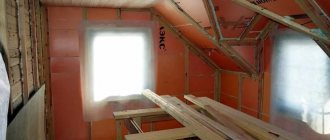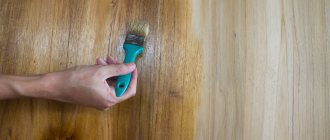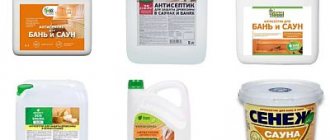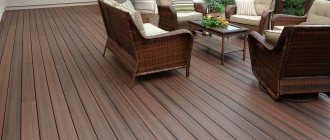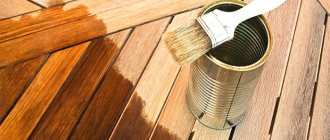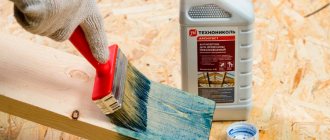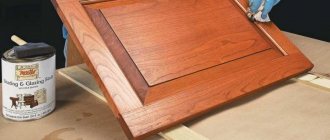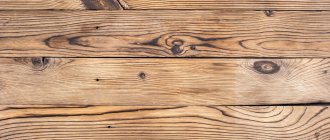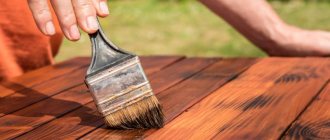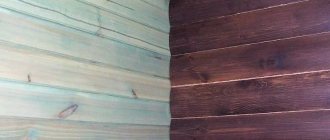If a residential or non-residential building has wooden floors, then it would be wrong to leave them without a protective finishing coating. Without it, the surface will quickly become dirty, worn out, covered with mold or damaged by microorganisms. Wooden floors are processed using different materials. They not only protect the surface and extend its service life, but also improve aesthetic performance, giving a matte or glossy shine, a certain color or shade, emphasizing the beauty of the wood texture. To understand how to treat a wooden floor, you need to take into account the purpose of the room, the temperature and humidity conditions in it, and the properties of the coating.
Antiseptics – protection against microorganisms
Antiseptics prevent the destructive effects of insects, fungi, viruses, putrefactive agents and other pests on wood. Often, antiseptics for outdoor use contain substances that protect the wooden surface from ultraviolet radiation and precipitation. It is important to pay attention to this when choosing an antiseptic for the flooring of a veranda or terrace.
Many modern antiseptics have water-repellent properties. This eliminates the possibility of warping, cracking and twisting of wooden floor elements during prolonged exposure to moisture.
Antiseptics can be prophylactic or therapeutic.
Prophylactic compositions represent the bulk of antiseptics. They treat undamaged wood for its subsequent protection during operation. A popular representative of such antiseptics is Neomid 400, which forms a colorless film on a wooden surface that prevents insects and bacteria from entering the tissue.
Therapeutic antiseptics contain more aggressive components that not only repel, but also destroy tree pests. These products are used on wooden surfaces that have already been damaged. Or where there are difficult operating conditions. For example, on wooden floors in bathhouses, where high humidity initially increases the risk of rotting. Here, medicinal antiseptics, to be on the safe side, are often used as preventatives.
The medicinal composition Neomid 100 Anti-bug has proven itself to be excellent, having a detrimental effect on bark beetles, shawls and other insect pests. The antiseptic Wood Healer DL-2 has a similar effect.
How to choose the best wood impregnation: consider the purpose of the purchase
Impregnation should be selected based on the location of the item being processed. What is suitable for finishing work indoors will not be suitable for items used outdoors.
Impregnation should be selected based on the location of the item being processed.
For interior work
Working inside a building requires the environmental friendliness and safety of impregnated components. It is optimal to use water-based solutions. Suitable products: antiseptic, moisture-resistant, fire-resistant.
It is optimal to use water-based solutions.
For outdoor use
Wood impregnation for exterior work is used as a barrier against the harmful effects of the environment. The use of antiseptic substances is optimal.
Wood impregnation for exterior work is used as a barrier against the harmful effects of the environment.
Fire retardants – fire protection
Fire-retardant impregnations protect wood from thermal destruction, that is, from ignition under the influence of heat or fire. The chemicals that make up fire retardants create compounds at high temperatures that prevent ignition or flame spread. Naturally, fire retardants are not a complete fire protection guarantee. They allow wooden surfaces to resist thermal aggression, but only for a short time (about 10-15 minutes when heated to 700˚C).
Fire retardants are recommended to be used to protect wooden floors in rooms where there is a source of ignition - a stove, fireplace, etc.
Based on their mode of action, fire-prevention impregnations are divided into 2 groups. The first includes fire retardants that prevent combustion. The second - blocking the spread of fire.
Fire retardants, which prevent combustion, begin to release non-flammable gases when the temperature rises. They push air away from the surface of the wood and thereby make combustion impossible.
Blocking flame retardants form a special film on the surface of the wood. When exposed to fire, this film swells and blocks the access of oxygen (necessary for combustion) to the protected surface.
Paints, primers, varnishes, plasters, etc. can be applied over fire retardants. Fire-fighting impregnations are often used in tandem with antiseptics. For best results, it is recommended to first apply a layer of antiseptic to the surface, then a fire retardant. For example, you can use the following scheme: the first 2-3 layers are Neomid 400 antiseptic, the next 2-3 layers are Neomid 530 fire protection.
Why do you treat wood floors?
The plank floor in a private house, apartment, balcony or non-residential premises is treated to protect against:
- spoilage by microorganisms;
- moisture;
- sunlight;
- mold;
- exposure to high and low temperatures.
Wood is especially susceptible to damage by microorganisms and mold in conditions of high humidity, so protection against moisture absorption is especially important. When the temperature and humidity in a room changes, wood absorbs and releases moisture, causing the material to shrink, swell and deform. Protective impregnation and varnish coating to some extent reduce the influence of these negative factors on the material and make the product more stable.
Covering the floor on an unheated balcony, loggia or veranda is necessary to protect it from moisture and sunlight. In addition, any coating reduces the degree of surface contamination, increases its wear resistance and strength.
Particular attention to the composition!
The quality of impregnation and its functional properties depend significantly on the composition. Protective preparations can be made based on water, oils and organic solvents. What is the difference?
Water-soluble compounds are liquid impregnations that are deeply absorbed into the wood structure. They are easy to apply to the surface with a brush or spray; drying time is 2-3 hours. They have low toxicity, are odorless and are excellent for treating indoor floors. Both antiseptics and fire retardants can be water-soluble.
Important feature: some water-soluble compounds are easily washed out with water. Therefore, in damp rooms it is recommended to apply film-forming varnishes or paints over such compositions. Elements in contact with water are not treated with water-washable impregnations.
Oil impregnations are thick oils that create a dense film on the surface being treated. They are highly flammable, but protect the wood for a long time from insects, rot, and fungi. Some of the oil formulations are toxic and have a strong odor, so they are used only for external treatment. The drying time for an oil-based composition is about 4 hours. Oil impregnations are applied independently, without finishing with varnishes and paints.
There are oil-based, water-soluble compounds on the market. They are low-toxic and are used both outdoors and indoors. Unlike oils, they can be colored with finishing paints and varnishes.
Impregnations based on volatile organic solvents are another group of compounds that have water-repellent properties and protect wooden surfaces from house fungus, mold, and insects. Such compositions are easy to apply, but take a long time to dry - about 12-24 hours. With their help, wood can be given a very deep, rich shade.
Useful video
Yes, it was surprisingly difficult to find a sane video. We stopped at this video because in it you will find references to compounds that were not found in our text - from the company TEKNOS. She is famous, she has facilities in Russia. Why not?
***
Finally, we would like to invite all of you to be more demanding customers, ask for the composition of the chemicals you are going to purchase and the certificates for it. Your health depends on this, so I would like to see real information, and not streamlined formulations.
Decorative properties of impregnations
Impregnations are produced transparent or tinted (in accordance with the manufacturer's range of tones). Only antiseptics have a decorative effect. Completely transparent (colorless) antiseptics perform an exclusively protective function without changing the natural color of the wood. The maximum they can do in decorative terms is to emphasize the structure of the wooden covering. A similar composition is Tikkurila Pinja W-Oil antiseptic. It is absolutely colorless, but can be easily tinted in any of the tones from the Tikkurila line.
Tinted antiseptics are originally colored. They are either produced in a specific color range, or are tinted upon sale, according to the color chart offered by the manufacturer. Such impregnations simultaneously play both a protective and decorative role. That is, they can replace other coloring materials: primers, stains, paints, varnishes. A well-known similar antiseptic is Pinotex Classic, its color card includes 10 main tones and 20 additional ones. In addition, the Pinotex Classic composition allows you to obtain many other tones by mixing existing shades in different proportions.
What about fire retardants? Most of them are colorless and once dry are not noticeable. Others are painted pink or red, which plays a controlling rather than a decorative role. By applying colored impregnation to a wooden surface, it is easier to monitor the quality of the coloring and the absence of gaps.
In addition to everything indicated, when choosing impregnation, pay attention to:
- Safety. Read the ingredients on the product label. Make sure that no highly toxic compounds are used in the manufacture of the antiseptic (fire retardant): arsenic, pentachlorophenol, fluorine compounds, heavy metal salts.
- Duration of fire and bioprotection. Fire retardants act on the treated surface for up to 7-15 years, antiseptics – for up to 10-20 years.
- Manufacturer. Well-known impregnating compositions that have a quality certificate and are appreciated by consumers are produced under the following brands: Pinotex (Finland), Tikkurila (Finland), Neomid (Russia), Senezh (Russia), Belinka (Slovenia).
Rules for applying protective compounds
Even the best antiseptic or fire retardant applied carelessly will not produce the desired effect. In order for the protective properties guaranteed on the label by the manufacturer to be fully manifested, you must adhere to the rules for applying impregnations. Follow the diagram:
Stage #1 - drying the wood
The best protection effect is achieved when applying impregnation to wood whose humidity does not exceed 20%. The drier the wood, the more protective agent it can absorb. And, conversely, wet wood will not allow impregnation into its pores, and the protective layer will be of poor quality. A similar effect will be especially noticeable when using impregnations based on organic solvents and oils.
To achieve the required humidity, the wood is dried in a shady, dry place. Best of all - under a canopy in the yard.
Stage #2 - surface cleaning
The wooden surface ready for impregnation must be clean, uniform, without traces of early staining. Contaminated areas lead to a deterioration in the absorbency of the protective composition and to an uneven, spotty color (if there is a color scheme).
If the surface has already been painted, remove the paint or varnish using a hair dryer. The remaining coating is removed with a scraper and a stiff brush. All oil and grease stains are washed off with white spirit.
Go over the cleaned wood with sandpaper or a sander, and blow off the dust with a vacuum cleaner.
Conclusion
In the video presented in this article you will find additional information on this topic. Also, based on the text presented above, we can conclude that there are quite a large number of different materials intended for impregnation of wood floors. Moreover, they all have their own unique properties, which must be selected taking into account the area of application.
If you need to buy a hovercraft inexpensively with organized delivery, call the phone numbers listed on the website, or write in the feedback form! Polite managers will tell you what the SVP tile leveling system is and how it can help you! In general, we will be glad to cooperate! See you in touch!
